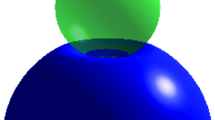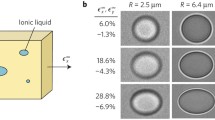Abstract
Cells are compressible and can be regarded as a kind of coated liquid inclusion embedded in a three-dimensional elastic matrix. In the presence of far-field loading, how the coating influences the mechanical response (e.g., volume change) of the liquid inclusion remains elusive, especially when surface tension effects become significant at cell size level. We developed a theoretical model to characterize the mechanical amplification or attenuation role of coating on spherical liquid inclusions, with surface tension and liquid compressibility accounted for. We found that surface tension could increase the volumetric strain of the inclusion through decreasing its effective bulk modulus. We further found that, when there is a monotonic stiffness variation (either decreasing or increasing) from matrix via coating to inclusion, the presence of coating amplified the volumetric strain compared with the case without coating; in the opposite, when there is a non-monotonic stiffness change from matrix via coating to inclusion, the volumetric strain is attenuated by the coating. The results are useful for understanding and exploring the mechanobiological sensation of certain types of cell, e.g., osteocytes and cancer cells.
Graphic Abstract








Similar content being viewed by others
References
Krishnan, R., Park, C.Y., Lin, Y.C., et al.: Reinforcement versus fluidization in cytoskeletal mechanoresponsiveness. PLoS ONE 4(5), e5486 (2009)
Chen, X., He, W., Liu, S., et al.: Volumetric response of an ellipsoidal liquid inclusion: implications for cell mechanobiology. Acta. Mech. Sin. 35(2), 338–342 (2019)
Chen, X., Li, M., Yang, M., et al.: The elastic fields of a compressible liquid inclusion. Extreme Mech. Lett. 22, 122–130 (2018)
Hagan, M.L., Yu, K., Zhu, J., et al.: Decreased pericellular matrix production and selection for enhanced cell membrane repair may impair osteocyte responses to mechanical loading in the aging skeleton. Aging Cell 19(1), e13056 (2020)
Khoshgoftar, M., Torzilli, P.A., Maher, S.A.: Influence of the pericellular and extracellular matrix structural properties on chondrocyte mechanics. J. Orthop. Res. 36(2), 721–729 (2018)
Verbruggen, S.W., Vaughan, T.J., Mcnamara, L.M.: Strain amplification in bone mechanobiology: a computational investigation of the in vivo mechanics of osteocytes. J. R. Soc. Interface 9(75), 2735–2744 (2012)
Wang, L., Dong, J., Xian, C.J.: Computational modeling of bone cells and their biomechanical behaviors in responses to mechanical stimuli. Crit. Rev. Eukaryot. Gene Expr. 29(1), 51–67 (2019)
Yu, H., Mouw, J.K., Weaver, V.M.: Forcing form and function: biomechanical regulation of tumor evolution. Trends Cell Biol. 21(1), 47–56 (2011)
Kumar, S., Weaver, V.M.: Mechanics, malignancy, and metastasis: the force journey of a tumor cell. Cancer Metastasis Rev. 28(1–2), 113–127 (2009)
Eshelby, J.D.: The determination of the elastic field of an ellipsoidal inclusion, and related problems. Pro. Roy. Soc. A 241(1226), 376–396 (1957)
Walpole, L.J.: A coated inclusion in an elastic medium. Math. Proc. Cambridge Philos. Soc. 83(3), 495–506 (1978)
Jayaraman, K., Reifsnider, K.L.: Residual stresses in a composite with continuously varying Young’s modulus in the fiber/matrix interphase. J. Compos. Mater. 26(6), 770–791 (1992)
Vörös, G., Pukánszky, B.: Effect of a soft interlayer with changing properties on the stress distribution around inclusions and yielding of composites. Compos. A 32(3), 343–352 (2001)
Duan, H.L., Wang, J., Huang, Z.P., et al.: Stress fields of a spheroidal inhomogeneity with an interphase in an infinite medium under remote loadings. Proc R Soc A 461(2056), 1055–1080 (2005)
Bertoldi, K., Bigoni, D., Drugan, W.J.: Structural interfaces in linear elasticity. Part II: Effective properties and neutrality. J. Mech. Phys. Solids 55(1), 35–63 (2007)
Yi, M.W., Huang, Z.P., Yan, Z., et al.: Effective moduli of particle-filled composite with inhomogeneous interphase: Part I–bounds. Compos. Sci. Technol. 64(9), 1345–1351 (2004)
Yan, Z., Wang, J., Yi, M.W., et al.: Effective moduli of particle-filled composite with inhomogeneous interphase: Part II–mapping method and evaluation. Compos. Sci. Technol. 64(9), 1353–1362 (2004)
Hashin, Z.: Thin interphase/imperfect interface in elasticity with application to coated fiber composites. J. Mech. Phys. Solids 50(12), 2509–2537 (2002)
Bai, S.L., Wang, G.T., Hiver, J.M., et al.: Microstructures and mechanical properties of polypropylene/polyamide 6/polyethelene-octene elastomer blends. Polymer 45(9), 3063–3071 (2004)
Ostoja-Starzewski, M., Jasiuk, I., Wang, W., et al.: Composites with functionally graded interphases: mesocontinuum concept and effective transverse conductivity. Acta Mater. 44(5), 2057–2066 (1996)
Wang, W., Jasiuk, I.: Effective elastic constants of particulate composites with inhomogeneous interphases. J. Compos. Mater. 32(15), 1391–1424 (1998)
Christensen, R.M., Lo, K.H.: Solutions for effective shear properties in three phase sphere and cylinder models. J. Mech. Phys. Solids 27(4), 315–330 (1979)
Mancarella, F., Wettlaufer, J.S.: Surface tension and a self-consistent theory of soft composite solids with elastic inclusions. Soft Matter 13(5), 945–955 (2017)
Xiao, J., Xu, B.-X., Xu, Y., et al.: The generalized self-consistent micromechanics prediction of the magnetoelectroelastic properties of multi-coated nanocomposites with surface effect. Smart Mater. Struct. 28(5), 055004 (2019)
Peng, C., Feng, J., Feiting, S., et al.: Modified two-phase micromechanical model and generalized self-consistent model for predicting dynamic modulus of asphalt concrete. Constr. Build. Mater. 201, 33–41 (2019)
Lurie, S., Solyaev, Y., Shramko, K.: Comparison between the Mori-Tanaka and generalized self-consistent methods in the framework of anti-plane strain inclusion problem in strain gradient elasticity. Mech. Mater. 122, 133–144 (2018)
Mancarella, F., Style, R.W., Wettlaufer, J.S.: Interfacial tension and a three-phase generalized self-consistent theory of non-dilute soft composite solids. Soft Matter 12(10), 2744 (2016)
Chen, X., Li, M., Liu, S., et al.: Mechanics tuning of liquid inclusions via bio-coating. Extreme Mech. Lett. 2020, 101049 (2020)
Shafiro, B., Kachanov, M.: Materials with fluid-filled pores of various shapes: Effective elastic properties and fluid pressure polarization. Int. J. Solids Struct. 34(27), 3517–3540 (1997)
Style, R.W., Wettlaufer, J.S., Dufresne, E.R.: Surface tension and the mechanics of liquid inclusions in compliant solids. Soft Matter 11(4), 672–679 (2015)
Guo, M., Pegoraro, A.F., Mao, A., et al.: Cell volume change through water efflux impacts cell stiffness and stem cell fate. Pro. Natl. Acad. Sci. USA 114(41), 201705179 (2017)
Wang, M., Yang, Y., Han, L., et al.: Cell mechanical microenvironment for cell volume regulation. J. Cell. Physiol. 235(5), 4070–4081 (2020)
Liu, A., Yu, T., Young, K., et al.: Cell mechanical and physiological behavior in the regime of rapid mechanical compressions that lead to cell volume change. Small 16(2), 1903857 (2020)
Amit, T., Ran, K., Lebleu, V.S., et al.: Cell growth and size homeostasis in proliferating animal cells. Science 325(5937), 167–171 (2009)
Hui, T.H., Zhou, Z.L., Qian, J., et al.: Volumetric deformation of live cells induced by pressure-activated cross-membrane ion transport. Phys. Rev. Lett. 113(11), 118101 (2014)
Badowski, C., Iskander, A., Gaspar, D., et al.: Molecular crowding–(in cell culture). Cell Eng. Regener. 2020, 483–509 (2020)
Watanabe, C., Yanagisawa, M.: Unique phase behavior in cell size space: synergistic effect of molecular crowding and confinement. Biophys. Rev. 12(2), 385 (2020)
Liao, H.S., Wen, P.J., Wu, L.G., et al.: Effect of osmotic pressure on cellular stiffness as evaluated through force mapping measurements. J. Biomech. Eng. 140(5), 054502 (2018)
Oh, D., Zidovska, A., Xu, Y., et al.: Development of time-integrated multipoint moment analysis for spatially resolved fluctuation spectroscopy with high time resolution. Biophys. J. 101(6), 1546–1554 (2011)
Jerome, I., Joe, S., Rui, P., et al.: Osmotic challenge drives rapid and reversible chromatin condensation in chondrocytes. Biophys. J. 104(4), 759–769 (2013)
Charras, G.T., Horton, M.A.: Determination of cellular strains by combined atomic force microscopy and finite element modeling. Biophys. J. 83(2), 858–879 (2002)
Kelly, G.M., Kilpatrick, J.I., Van Es, M.H., et al.: Bone cell elasticity and morphology changes during the cell cycle. J. Biomech. 44(8), 1484–1490 (2011)
Rubiano, A., Galitz, C., Simmons, C.S.: Mechanical characterization by mesoscale indentation: advantages and pitfalls for tissue and scaffolds. Tissue Eng. Part C 25(10), 619–629 (2019)
Kostic, A., Lynch, C.D., Sheetz, M.P.: Differential matrix rigidity response in breast cancer cell lines correlates with the tissue tropism. PLoS ONE 4(7), e6361 (2009)
Lam, W.A., Cao, L., Umesh, V., et al.: Extracellular matrix rigidity modulates neuroblastoma cell differentiation and N-myc expression. Mol. Cancer 9(1), 35 (2010)
Pathi, S.P., Kowalczewski, C., Tadipatri, R., et al.: A novel 3-D mineralized tumor model to study breast cancer bone metastasis. PLoS ONE 5(1), e8849 (2010)
Menton, D., Simmons, D., Chang, S.L., et al.: From bone lining cell to osteocyte—an SEM study. Anatom. Record 209(1), 29–39 (1984)
Wells, R.G.: The role of matrix stiffness in regulating cell behavior. Hepatology 47(4), 1394–1400 (2008)
Yeh, W.-C., Li, P.-C., Jeng, Y.-M., et al.: Elastic modulus measurements of human liver and correlation with pathology. Ultrasound Med. Biol. 28(4), 467–474 (2002)
Ladjal, H., Hanus, J.L., Pillarisetti, A., et al.: Atomic force microscopy-based single-cell indentation: experimentation and finite element simulation. in: International Conference on Intelligent Robots and Systems. St. Louis, MO (2009)
Ding, Y., Xu, G.-K., Wang, G.-F.: On the determination of elastic moduli of cells by AFM based indentation. Sci. Rep. 7, 45575 (2017)
Sugawara, Y., Ando, R., Kamioka, H., et al.: The three-dimensional morphometry and cell–cell communication of the osteocyte network in chick and mouse embryonic calvaria. Calcif. Tissue Int. 88(5), 416–424 (2011)
Sugawara, Y., Ando, R., Kamioka, H., et al.: The alteration of a mechanical property of bone cells during the process of changing from osteoblasts to osteocytes. Bone 43(1), 19–24 (2008)
McCreadie, B.R., Hollister, S.J.: Strain concentrations surrounding an ellipsoid model of lacunae and osteocytes. Comput. Methods Biomech Bio Med. Eng. 1(1), 61–68 (1997)
Guilak, F., Alexopoulos, L.G., Upton, M.L., et al.: The pericellular matrix as a transducer of biomechanical and biochemical signals in articular cartilage. Ann. N. Y. Acad. Sci. 1068(1), 498–512 (2006)
Kato, N., Koshino, T., Saito, T., et al.: Estimation of Young’s modulus in swine cortical bone using quantitative computed tomography. Bulletin. 57(4), 183–186 (1998)
Han, Y.L., Ronceray, P., Xu, G., et al.: Cell contraction induces long-ranged stress stiffening in the extracellular matrix. Proc. Natl. Acad. Sci. 115(16), 4075–4080 (2018)
Ronceray, P., Broedersz, C.P., Lenz, M.: Fiber networks amplify active stress. Proc. Natl. Acad. Sci. 113(11), 2827–2832 (2016)
Ban, E., Wang, H., Franklin, J.M., et al.: Strong triaxial coupling and anomalous Poisson effect in collagen networks. Proc. Natl. Acad. Sci. 116(14), 6790–6799 (2019)
Fletcher, D.A., Mullins, R.D.: Cell mechanics and the cytoskeleton. Nature 463(7280), 485–492 (2010)
Jiang, H., Sun, S.X.: Cellular pressure and volume regulation and implications for cell mechanics. Biophys. J. 105(3), 609–619 (2013)
Acknowledgements
This work was financially supported by the National Natural Science Foundation of China (Grants 12032010, 11532009, and 11902155), the Natural Science Foundation of Jiangsu Province (Grant BK20190382), the foundation of “Jiangsu Provincial Key Laboratory of Bionic Functional Materials”, the Foundation for the Priority Academic Program Development of Jiangsu Higher Education Institutions.
Author information
Authors and Affiliations
Corresponding authors
Additional information
Publisher's Note
Springer Nature remains neutral with regard to jurisdictional claims in published maps and institutional affiliations.
Executive Editor: Xi-Qiao Feng.
Electronic supplementary material
Below is the link to the electronic supplementary material.
Rights and permissions
About this article
Cite this article
Ti, F., Chen, X., Yang, H. et al. A theory of mechanobiological sensation: strain amplification/attenuation of coated liquid inclusion with surface tension. Acta Mech. Sin. 37, 145–155 (2021). https://doi.org/10.1007/s10409-020-01017-3
Received:
Revised:
Accepted:
Published:
Issue Date:
DOI: https://doi.org/10.1007/s10409-020-01017-3




